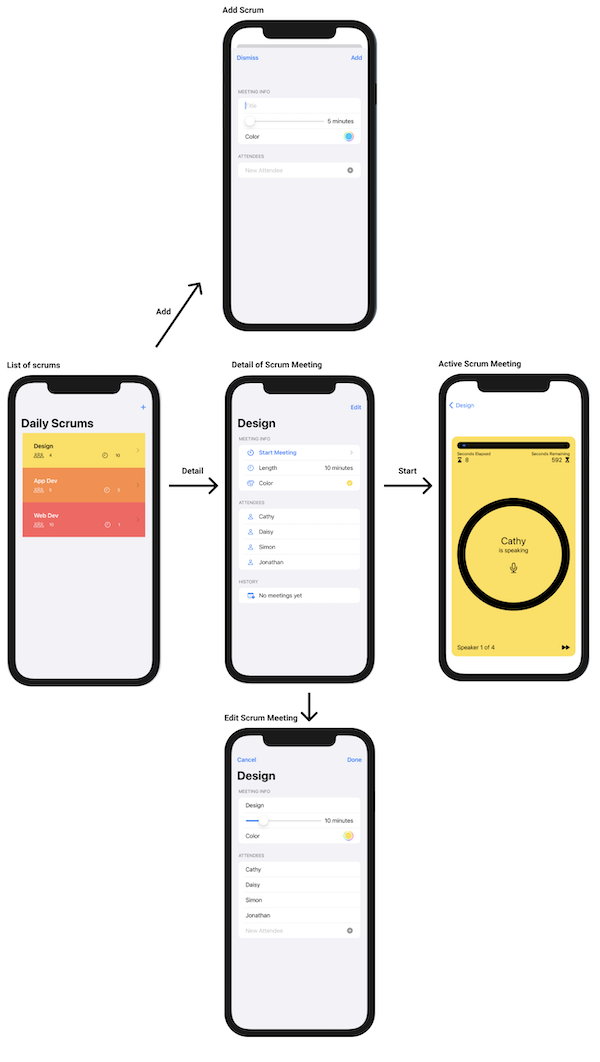This repo contains Scrumdinger app from Apple's tutorial, rewritten in uni-directional architecture Composable Architecture.
I created this repo to learn & explore the Composable Architecture that was made by Brandon Williams and Stephen Celis.
Instead of starting with greenfield Xcode project I decided to pickup the final version of Scrumdinger app, that seemed to me to be just at the right size for this exercise. I walked through the official Apple tutorial prior to starting the project migration to CA. The familiarity with the Scrumdinger project was a plus. When it comes down to Composable Architecture, it comes with plenty of examples and case-studies that showcase how to tackle most of the common challenges. This was great resource at the times I felt litlle bit stucked with the migration.
I decided to open-source my findings to help others and me to improve the understanding of the Composable Architecture.
Note:
This project is in highly experimental/prototyping stage and is not meant for production use.
In terms of functionality/features, this project aims to be 1:1 consistent with the of the Apple's Scrumdinger app, but don't expect me to not break the things along the way :)
Scrumdinger app gives you possibility to maintain your scrum meetings. Scrum meetings can be added, edited, started & recorded.
Every scrum meeting has following attributes:
- name
- length
- color
- list of attendees
- history of transcripts from previous meetings
Below you can find the basic user flow of the Scrumdinger app.

In this section I'll roughly talk about my approaches that I took when rewriting the Scrumdinger app's vanilla SwiftUI into Composable Architecture.
I won't talk about uni-directional architecture, its pros or cons here. There's already quantum of articles that discuss this topic, and on top of that, I'll rather go straight to the point.
By looking at the app's view hierarchy I naturally started to rewrite the views from the bottom up.
Note: There are few views/components left untouched, since applying the CA to them wouldn't add much value

Thanks to SwiftUI previews this gave me the opportunity to iteratively rewrite views & the state management behind them without declaring the World War III against the Swift compiler.
The pattern that I repeated several times in this project was to actually declare a dedicated State, Actions, Environment and Reducer for each view in 1:1 ratio.
How did it look like in the simplest case? Here are few steps that I followed when turning the MeetingFooterView into CA.
struct MeetingFooterView: View {
let speakers: [ScrumTimer.Speaker]
private var speakerNumber: Int? { ... }
private var isLastSpeaker: Bool { ... }
private var speakerText: String { ... }
var skipAction: () -> Void
var body: some View {
...
}
}- First of all, add
ComposableArchitecturepackage to the project. - Import CA in the source file
import ComposableArchitecture.
Identify all the properties that keep the view's state and move them to standalone State struct(or enum) that conforms to Equatable protocol.
struct MeetingFooterView: View {
- let speakers: [ScrumTimer.Speaker]
- private var speakerNumber: Int? { ... }
- private var isLastSpeaker: Bool { ... }
- private var speakerText: String { ... }
var skipAction: () -> Void
var body: some View {
...
}
}Turn all properties to access level of your store - eg from private to internal.
struct MeetingFooterState: Equatable {
let speakers: [ScrumTimer.Speaker]
var speakerNumber: Int? { ... }
var isLastSpeaker: Bool { ... }
var speakerText: String { ... }
}Note: Comment out all the lines of code that don't compile at this moment. You'll uncomment them once you're ready!
Identify actions in your view and model them via equatable enum. Actions doesn't necessarily need to be user-initiated.
struct MeetingFooterView: View {
- var skipAction: () -> Void
var body: some View {
...
}
}👇
enum MeetingFooterAction: Equatable {
case skipSpeaker
}Declare the corresponding environment struct if needed. In this case, I skipped the declaration of the environment, as there wasnt need for it.
Maybe I did something wrong, but I found out that I didn't need to declare reducer for this view. With that being said, I didn't need to use Effects within this view.
Declare and use the store in the SwiftUI view.
- Declare the
storeproperty, that contains two associated values. Your newly createdMeetingFooterStateandMeetingFooterAction.
struct MeetingFooterView: View {
+ let store: Store<MeetingFooterState, MeetingFooterAction>
var body: some View {
...
}
}- Use
viewStorein thebodyof your view by calling following API -WithViewStore(store) { viewStore in ... }
struct MeetingFooterView: View {
let store: Store<MeetingFooterState, MeetingFooterAction>
var body: some View {
+ WithViewStore(store) { viewStore in
...
+ }
}
}- Access the
statethrough the passed inviewStoreparameter.
struct MeetingFooterView: View {
let store: Store<MeetingFooterState, MeetingFooterAction>
var body: some View {
WithViewStore(store) { viewStore in
VStack {
HStack {
+ if viewStore.isLastSpeaker {
...
} else {
+ Text(viewStore.speakerText)
...
}
}
}
...
}
}
}- Send the
actionto the store by using theviewStore.send(MeetingFooterAction)API.
Button(action: { viewStore.send(.skipSpeaker) } )- Update your preview provider to conform to the new API. Tadaaa
struct MeetingFooterView_Previews: PreviewProvider {
static var speakers = ...
static var previews: some View {
MeetingFooterView(store: Store<MeetingFooterState, MeetingFooterAction>(initialState: MeetingFooterState(speakers: speakers),
reducer: .empty,
environment: ()))
.previewLayout(.sizeThatFits)
}
}Please look at License for more details.